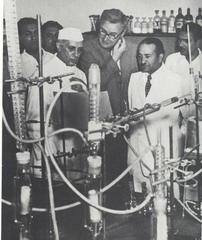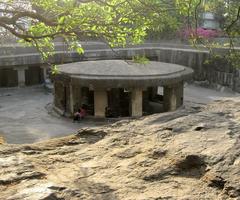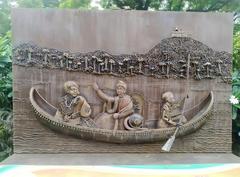Dashabhuja Temple Pune: Visiting Hours, Tickets, History & Complete Guide
Date: 04/07/2025
Introduction
The Dashabhuja Temple, nestled on Karve Road in Pune, Maharashtra, stands as a revered spiritual and historical landmark dedicated to Lord Ganesha in his rare ten-armed (Dashabhuja) form. This iconic temple, renowned for its unique idol and striking Peshwa-era architecture, draws thousands of devotees and visitors each year, serving as a testament to Pune’s vibrant religious and cultural heritage. Established in the 18th century by Sardar Haripant Phadke—a notable noble from the Peshwa court—Dashabhuja Temple is more than a place of worship; it is a living monument to the Maratha tradition of devotion, artistic patronage, and community celebration (Indianetzone; AstroVed; Wikipedia: History of Pune).
This guide covers the temple’s rich history, architectural marvels, practical visiting information (including hours, entry, and accessibility), cultural significance, nearby attractions, and essential tips to enhance your visit.
Historical Evolution of Dashabhuja Temple
Origins and Peshwa Patronage
Dashabhuja Temple’s origins trace back to the 18th century during the height of Pune’s Peshwa era. Sardar Haripant Phadke, a prominent military leader in the Peshwa court, established the temple after discovering a sacred idol of Lord Ganesha on his estate. The temple later became part of the Peshwa’s extensive network of temples, gifted as dowry and integrated into Pune’s religious landscape (Indianetzone; Devdeveshwar Sansthan). Peshwa patronage was instrumental in the temple’s upkeep, rituals, and festivals, embedding Dashabhuja into the city’s cultural fabric (Wikipedia: History of Pune).
Architectural Features
Layout and Design
Dashabhuja Temple’s architecture is a testament to Peshwa artistry. Built in the Nagara style, the temple features:
- Elevated Platform & Steps: The temple sits atop a raised plinth, accessed by a broad flight of steps adorned with intricate balustrades.
- Mandap (Hall): A spacious, pillared hall with polished basalt flooring facilitates smooth movement and large gatherings, especially during festivals (Pune Tourism).
- Sanctum Sanctorum (Garbhagriha): Houses the rare ten-armed stone idol of Lord Ganesha, accompanied by Riddhi, symbolizing prosperity and spiritual fulfillment.
Shikhara and Ornamentation
- Shikhara (Spire): The temple’s curvilinear spire, adorned with miniature spires (urushringas) and a golden kalash, creates a majestic silhouette.
- Decorative Elements: The temple displays intricate carvings of mythological scenes, floral motifs, and auspicious symbols. Brass and silver embellishments on the sanctum doors and idol’s throne enhance the sacred atmosphere (Cultural India).
Auxiliary Shrines
- Hanuman Shrine: A smaller shrine dedicated to Lord Hanuman is located within the complex, reflecting the inclusive spirit of Maratha worship traditions.
The Dashabhuja Ganapati Idol
- Material & Iconography: The main idol, carved from black stone, stands approximately 2.5 feet high. It features ten arms holding symbolic objects such as the lotus, axe, modak, conch, and discus. The trunk curves left, denoting auspicious energy.
- Unique Features: The idol is believed to be self-manifested (svayambhu) and is adorned daily with silver ornaments and fresh flowers.
- Spiritual Significance: The ten arms symbolize Ganesha’s omnipotence, and his seated posture radiates compassion and wisdom (Times of India).
Visiting Information
Timings and Entry
- Visiting Hours: Daily, 6:00 AM – 9:00 PM. Special extended hours may be available during major festivals (Pune Tourism; TemplePurohit).
- Entry Fee: Free for all visitors. Donations are welcomed to support temple maintenance and activities.
How to Reach
- Address: Karve Road, Erandwane, Pune, Maharashtra.
- By Bus: Nearest stop is Karve Road SNDT College; Pune’s bus network is reliable and connects major city hubs.
- By Metro: Ideal Colony and Nal Stop metro stations are within walking distance.
- By Taxi/Auto: Readily available across Pune.
- By Private Car: Limited parking is available, especially during festivals; arrive early to secure a spot.
Accessibility and Facilities
- Wheelchair Access: Ramps and handrails are provided, though the temple can become crowded during festivals.
- Amenities: Footwear stand, drinking water, restrooms, and shops selling offerings are available for visitor convenience.
Rituals, Festivals, and Cultural Significance
- Daily Rituals: Multiple pujas, abhisheka (ceremonial bathing), and aarti (ritual worship) are performed. Devotees offer flowers, sweets, and coconuts, and receive prasad.
- Major Festivals:
- Ganesh Chaturthi: The temple transforms into a hub of celebration with elaborate decorations, music, and processions.
- Sankashti Chaturthi & Maghi Ganesh Jayanti: Special rituals and increased attendance mark these auspicious days (ZeeZest).
- Other Shrines: Special worship for Lord Hanuman takes place on Saturdays.
- Community Role: The temple’s association with Peshwa-era Ganesh worship established its significance in Pune’s renowned Ganeshotsav celebrations (Wikipedia: History of Pune).
Nearby Attractions
- Mrutunjayeshwar Temple: Five minutes away; managed by the same trust (TemplePurohit).
- Sarasbaug Ganapati Temple: Another prominent Ganesh temple nearby.
- Cultural Landmarks: Shaniwar Wada Fort, Dagdusheth Halwai Ganpati Temple, and Saras Baug Park are within a short distance.
Tips for Visitors
- Best Time to Visit: Early mornings and weekday evenings are less crowded. Festival days offer a vibrant experience but expect long queues.
- Dress Code: Modest attire is recommended. Cover shoulders and knees.
- Photography: Not permitted inside the sanctum; allowed in the outer areas—avoid using flash during rituals (TemplePurohit).
- Maintain Decorum: Keep phones silent and respect ongoing rituals.
- Combine Visits: Explore nearby temples and cultural sites for a fuller experience.
- Language: Marathi, Hindi, and English are spoken by staff and volunteers.
Frequently Asked Questions (FAQ)
Q: What are the temple’s visiting hours?
A: 6:00 AM to 9:00 PM daily.
Q: Is there an entry fee?
A: No, entry is free.
Q: Are guided tours available?
A: No official tours, but heritage walks are organized during major festivals (Pune Mirror).
Q: What is the best time to visit?
A: Early mornings and weekdays for a peaceful visit; Ganesh Chaturthi for grand festivities.
Q: Is the temple wheelchair accessible?
A: Yes, with ramps and handrails in place.
Q: Is photography allowed inside?
A: Photography is not permitted inside the sanctum.
Visuals and Maps
Include images such as “Dashabhuja Temple Pune shikhara,” “Dashabhuja Ganapati idol close-up,” and “Ganesh Chaturthi celebrations at Dashabhuja Temple.”
Embed a Google Map showing the temple’s location on Karve Road, Pune, for visitor convenience.
Further Reading and Official Sources
For more information and updates, refer to these official and authoritative sources:
- Indianetzone: Dashabhuja Temple
- AstroVed: Dashabhuja Ganapati Temple
- Wikipedia: History of Pune
- Pune Mirror: Heritage Walk
- TemplePurohit: Dashabhuja Temple
- ZeeZest: Famous Ganpati Temples
- Pune Tourism: Dashabhuja Ganapati Temple
- Devdeveshwar Sansthan Official Site
Summary and Travel Tips
The Dashabhuja Temple in Pune exemplifies a harmonious blend of historical grandeur, architectural beauty, and enduring spiritual significance. Open daily with free entry, the temple welcomes visitors to immerse themselves in its tranquil ambiance, participate in vibrant festivals, and appreciate its rich legacy. Its strategic location, accessibility by various modes of transport, and proximity to other historic temples make it a central part of Pune’s religious and cultural circuit. The temple’s maintenance by Shri Devdeveshwar Sansthan ensures its continued heritage and spiritual traditions, while heritage walks and local guided tours offer deeper insights into Pune’s Ganapati worship legacy (Indianetzone; TemplePurohit; ZeeZest).
For a fulfilling visit, plan for early mornings or weekdays for peace, or embrace the vibrant atmosphere during Ganesh Chaturthi. Explore nearby sites like Mrutyunjayeshwar and Sarasbaug Ganapati Temples, and consider using the Audiala app for guided tours and real-time updates.
Plan your visit, stay informed, and experience the spiritual and cultural richness of Pune’s Dashabhuja Ganapati Temple.




